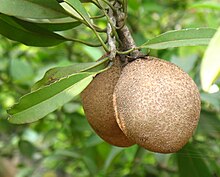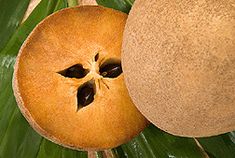Manilkara zapota, commonly known as sapodilla (Spanish: [ˌsapoˈðiʝa]),[4] sapote, chicozapote, chicoo, chicle, naseberry, nispero, or soapapple, among other names,[5][6]: 515 is an evergreen tree native to southern Mexico and Central America. An example natural occurrence is in coastal Yucatán, in the Petenes mangroves ecoregion, where it is a subdominant plant species.[7] It was introduced to the Philippines during Spanish colonization.[8] It is grown in large quantities in Mexico and in tropical Asia, including India, Pakistan, Thailand, Malaysia, Cambodia, Indonesia, Vietnam, Bangladesh, as well as in the Caribbean.
| Manilkara zapota | |
|---|---|

| |
| Scientific classification | |
| Kingdom: | Plantae |
| Clade: | Tracheophytes |
| Clade: | Angiosperms |
| Clade: | Eudicots |
| Clade: | Asterids |
| Order: | Ericales |
| Family: | Sapotaceae |
| Genus: | Manilkara |
| Species: | M. zapota
|
| Binomial name | |
| Manilkara zapota (L.) P.Royen
| |
| Synonyms | |
 Fruit, cross-section | |||||||||||||||||||||||||||||||||||||||
| Nutritional value per 100 g (3.5 oz) | |||||||||||||||||||||||||||||||||||||||
|---|---|---|---|---|---|---|---|---|---|---|---|---|---|---|---|---|---|---|---|---|---|---|---|---|---|---|---|---|---|---|---|---|---|---|---|---|---|---|---|
| Energy | 347 kJ (83 kcal) | ||||||||||||||||||||||||||||||||||||||
19.96 g | |||||||||||||||||||||||||||||||||||||||
| Dietary fiber | 5.3 g | ||||||||||||||||||||||||||||||||||||||
1.1 g | |||||||||||||||||||||||||||||||||||||||
0.44 g | |||||||||||||||||||||||||||||||||||||||
| |||||||||||||||||||||||||||||||||||||||
| †Percentages estimated using US recommendations for adults,[2] except for potassium, which is estimated based on expert recommendation from the National Academies.[3] | |||||||||||||||||||||||||||||||||||||||
Common names
editMost of the common names of Manilkara zapota like "sapodilla", "chiku", and "chicozapote" come from Spanish meaning "little sapote".[6]: 515 Other common names in English include bully tree, soapapple tree, sawo, marmalade plum[9] and dilly tree.[citation needed]
The specific epithet zapota is from the Spanish zapote [saˈpote], which ultimately derives from the Nahuatl word tzapotl used for other similar looking fruits.[6]: 519, 521
Description
editSapodilla trees can live up to one hundred years.[10][11] It can grow to more than 30 m (98 ft) tall with a trunk diameter of up to 1.5 m (5 ft); but the average height of cultivated specimens is usually between 9 and 15 m (30 and 49 ft) with a trunk diameter not exceeding 50 cm (20 in).[12] It is wind-resistant and the bark is rich in a white, gummy latex called chicle. Its leaves are elliptic to ovate 6–15 cm (2–6 in) long with entire margins on 1–3 cm (0–1 in) long petioles; they are medium green and glossy with brown and slightly furry midribs. They are arranged alternately.[13]
The trees can survive only in warm, typically tropical environments (although it has low tolerance to drought and heat in its early years),[14] dying easily if the temperature drops below freezing. From germination, the sapodilla tree will usually take anywhere from five to eight years to bear fruit. The sapodilla trees yield fruit twice a year, though flowering may continue year round.[15]
The white flowers are inconspicuous and bell-like, with a six-lobed corolla.
Fruit
editThe fruit is a large berry, 4–8 cm (2–3 in) in diameter.[13][16] An unripe fruit has a firm outer skin and when picked, releases white chicle from its stem. A fully ripened fruit has saggy skin and does not release chicle when picked. Inside, its flesh ranges from a pale yellow to an earthy brown color with a grainy texture akin to that of a well-ripened pear. Each fruit contains one to six seeds.[16] The seeds are hard, glossy, and black, resembling beans, with a hook at one end that can catch in the throat if swallowed.
The fruit has an exceptionally sweet, malty flavor. The unripe fruit is hard to the touch and contains high amounts of saponin, which has astringent properties similar to tannin, drying out the mouth.[citation needed]
Biological studies
editCompounds extracted from the leaves showed anti-diabetic, antioxidant and hypocholesterolemic (cholesterol-lowering) effects in rats.[17]
Acetone extracts of the seeds exhibited in vitro antibacterial effects against strains of Pseudomonas oleovorans and Vibrio cholerae.[18]
Synonyms
editSynonyms of this species include:[19]
- Achradelpha mammosa (L.) O.F.Cook
- Achras breviloba (Gilly) Lundell
- Achras calderonii (Gilly) Lundell
- Achras conzattii (Gilly) Lundell
- Achras coriacea Lundell
- Achras dactylina Lundell
- Achras gaumeri (Gilly) Lundell
- Achras latiloba Lundell
- Achras lobulata (Lundell) Lundell
- Achras lucuma Blanco
- Achras mammosa L. nom. illeg.
- Achras meridionalis (Gilly) Lundell
- Achras occidentalis Cels ex Ten.
- Achras paludosa Lundell
- Achras petenensis (Lundell) Lundell
- Achras rojasii (Gilly) Lundell
- Achras sapatilla J.Paul & W.Arnold
- Achras sapota L. [Spelling variant]
- Achras striata (Gilly) Lundell
- Achras tabogaensis (Gilly) Lundell
- Achras tainteriana Lundell
- Achras tchicoomame Perr.
- Achras verrucosa Stokes
- Achras zapota L.
- Achras zapotilla (Jacq.) Nutt.
- Calocarpum mammosum (L.) Pierre
- Calospermum mammosum (L.) Pierre
- Gambeya mammosa (L.) Pierre
- Lucuma mammosa (L.) C.F.Gaertn.
- Lucuma zapota (L.) Urb.
- Manilkara achras (Mill.) Fosberg
- Manilkara breviloba Gilly
- Manilkara calderonii Gilly
- Manilkara conzattii Gilly
- Manilkara gaumeri Gilly
- Manilkara grisebachii (Pierre) Dubard
- Manilkara meridionalis Gilly
- Manilkara rojasii Gilly
- Manilkara striata Gilly
- Manilkara tabogaensis Gilly
- Manilkara zapotilla (Jacq.) Gilly
- Manilkariopsis lobulata Lundell
- Manilkariopsis meridionalis (Gilly) Lundell
- Manilkariopsis petenensis Lundell
- Manilkariopsis rojasii (Gilly) Lundell
- Manilkariopsis striata (Gilly) Lundell
- Manilkariopsis tabogaensis (Gilly) Lundell
- Mimusops grisebachii Pierre
- Nispero achras (Mill.) Aubrév.
- Pouteria mammosa (L.) Cronquist
- Sapota achras Mill.
- Sapota zapotilla (Jacq.) Coville ex Safford
- Vitellaria mammosa (L.) Radlk.
Uses
editThe fruit is edible and a favorite in the tropical Americas.[20] Chicle from the bark is used to make chewing gum.
See also
editReferences
edit- ^ Martínez Salas, E.; Samain, M. & Oldfield, S. (2021). "Manilkara zapota". IUCN Red List of Threatened Species. 2021: e.T61964429A61964470. Retrieved 23 June 2022.
- ^ United States Food and Drug Administration (2024). "Daily Value on the Nutrition and Supplement Facts Labels". FDA. Archived from the original on 2024-03-27. Retrieved 2024-03-28.
- ^ National Academies of Sciences, Engineering, and Medicine; Health and Medicine Division; Food and Nutrition Board; Committee to Review the Dietary Reference Intakes for Sodium and Potassium (2019). Oria, Maria; Harrison, Meghan; Stallings, Virginia A. (eds.). Dietary Reference Intakes for Sodium and Potassium. The National Academies Collection: Reports funded by National Institutes of Health. Washington, DC: National Academies Press (US). ISBN 978-0-309-48834-1. PMID 30844154. Archived from the original on 2024-05-09. Retrieved 2024-06-21.
- ^ USDA, NRCS (n.d.). "Manilkara zapota". The PLANTS Database (plants.usda.gov). Greensboro, North Carolina: National Plant Data Team. Retrieved 23 June 2022.
- ^ "Manilkara zapota". Germplasm Resources Information Network. Agricultural Research Service, United States Department of Agriculture. Retrieved 23 June 2022.
- ^ a b c Small, Ernest (2011). Top 100 Exotic Food Plants. Boca Raton, Louisiana, USA: CRC Press. pp. 515–524. ISBN 9781439856888.
- ^ World Wildlife Fund. eds. Mark McGinley, C.Michael Hogan & C. Cleveland. 2010. Petenes mangroves. Encyclopedia of Earth. National Council for Science and the Environment. Washington DC Archived 2011-10-15 at the Wayback Machine
- ^ Fernandez, Doreen G. (1997). Fruits of the Philippines. Makati City, Luzon, Philippines: Bookmark Inc. p. 22. ISBN 9715692613.
- ^ "Manilkara zapota". European and Mediterranean Plant Protection Organization (EPPO). Retrieved 23 June 2022.
- ^ Horticulture: Crop Plantation Guidence - The Sapota (Chickoo). India Agro. Retrieved 8 August, 2023.
- ^ Introduction to Sapota. Agri Farming. Retrieved 14 August, 2023.
- ^ Manilkara zapota Sapotaceae (L.) van Royen, Orwa C, Mutua A, Kindt R, Jamnadass R, Simons A. 2009. Agroforestree Database:a tree reference and selection guide version 4.0 (http://www.worldagroforestry.org/af/treedb/)
- ^ a b "Manilkara zapota". Flora of North America. Vol. 8. New York and Oxford: Flora of North America Association. 2009. pp. 232, 234–235 – via eFloras.
- ^ Growing Sapodilla: Manilkara zapota. Garden Oracle. Retrieved 8 August, 2023. "Heat tolerant: These trees have difficulty when young, over 90°F, and when mature, over 105°F. They will need afternoon shade and extra water in these temperatures. Drought tolerant: Yes, after three years."
- ^ Kute, L.S.; Shete, M.B. (1995). "Sapota (Sapodilla)". Handbook of Fruit Science and Technology. CRC Press. pp. 475–476. doi:10.1201/9781482273458-31. ISBN 9780429152733. Retrieved 24 August 2022.
- ^ a b Harris, Kate (2009). Trees of Belize. Belize: Bay Cedar Publishing. pp. 94–95. ISBN 9780992758202.
- ^ Fayek NM, Monem AR, Mossa MY, Meselhy MR, Shazly AH (2012). "Chemical and biological study of Manilkara zapota (L.) Van Royen leaves (Sapotaceae) cultivated in Egypt". Pharmacognosy Research. 4 (2): 85–91. doi:10.4103/0974-8490.94723. PMC 3326762. PMID 22518080.
- ^ Kothari V, Seshadri S (2010). "In vitro antibacterial activity in seed extracts of Manilkara zapota, Anona squamosa, and Tamarindus indica". Biol. Res. 43 (2): 165–8. doi:10.4067/S0716-97602010000200003. PMID 21031260.
- ^ "Calotropis gigantea (L.) P. Royen". Plants of the World Online. Royal Botanic Gardens, Kew. 2024. Retrieved 4 May 2024.
- ^ Hargreaves, Dorothy; Hargreaves, Bob (1964). Tropical Trees of Hawaii. Kailua, Hawaii: Hargreaves. p. 14.
